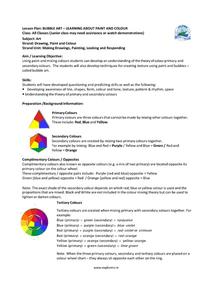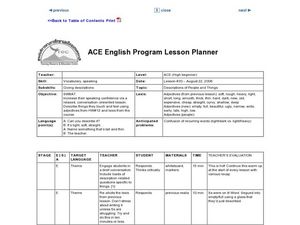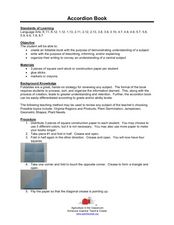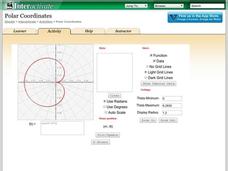Curated OER
Net - With Traced Answers
Learners study four pictures, each with a net and a describing word. They trace over provided answers to finish four sentences. A basic worksheet that provides good practice.
Curated OER
Skate (Traced Answers)
Young readers study four pictures of skates, and their descriptive label. They complete four sentences by tracing over a provided answer. A basic worksheet that provides good practice.
American Museum of Natural History
Feed the Birds
Scholars use a large carton, string, an emery board, and bird food to create a hand-made bird feeder. After completing the craft, pupils keep a journal to track their observations.
Marine Institute
Bubble Art – Learning About Paint and Color
To gain an understanding of color mixing theory and the color wheel, young artists draw a picture, mix up a batch of secondary colors to which they add dish soap, and using straws, bubble up the paint....
Curated OER
Homographs
There are eight homograph riddles here: can your scholars figure them out? For each, there are three definitions and a picture. Learners use the picture and multiple meanings as clues, recording a word that matches all three. They read...
Curated OER
Conejito
Third graders read the story "Conejito" and write a descriptive story about the rainforest in Panama. They answer story comprehension questions, complete worksheet questions about a map of Panama, and rewrite a paragraph changing the...
Curated OER
Description of People and Things
Elementary schoolers use adjectives correctly in their speech. They demonstrate adjectives using familiar objects. (For example, they might show narrow by walking between two chairs placed closely together.) Then they play antonym Bingo...
Read Theory
Analogies 3 (Level 6)
Positive and negative may be opposites, but what does that have to do with the words clean and filthy? Ask your pupils to consider word relationships as they complete the 10 analogies presented here. Note that the exercise gradually...
ESL Kid Stuff
Describing Things (Adjectives)
Describing things using adjectives is the focus of this lesson designed for language learners. Class members play games, draw pictures, and sing songs, adding adjectives to describe animals.
Arizona Department of Education
Introduction to Integers
Welcome to the backward world of negative numbers. This introductory lesson teaches young mathematicians that negative numbers are simply the opposite of positive numbers as they use number lines to plot and compare...
Helping Dyslexia
Chain Words
Kindergartners and first graders create a chain of word cards with this fun activity. Participants read the word on the right side of a card, and match the word to the corresponding picture on the left side of another card....
Curated OER
Andrew Jackson: 1767-1845
A thorough examination of Andrew Jackson's presidency and politics, these slides contain important facts and pictures of the growing United States. Events such as the Trail of Tears and the Tariff Battles of the early 19th century are on...
Curated OER
Seasons and Day Time
Learners label a diagram of the Earth rotating about the sun and indicate the direction of the rotation and the seasons at each location. They indicate the seasons, the poles, the hours of daylight at each pole, the direction of rotation...
Curated OER
Vocabulary Packet: Multiple Approaches
Looking for a complete vocabulary and spelling packet focused on high frequency words? Look no further. This printable packet includes six worksheets with activities to reinforce spelling and vocabulary competency. Learners complete a...
Curated OER
Accordion Book
Students make an accordion book to show information that is associated with a particular learning event. In this accordion book lesson, students follow paper-folding directions to make the book. They fill the book with key facts and...
Curated OER
Italian Fascism
By first defining the characteristics and ideology of fascism, this presentation makes it easy for viewers to contextualize the rise of Mussolini in post-WWI Italy. Not only thorough and informative, the pictures and concepts featured in...
Curated OER
Attract or Repel?
Opposites attract with a fun science experiment on magnets. With a short paragraph on background knowledge, the lab sheet prompts third and fourth graders to choose which pairs of magnets will attract, and which pairs will repel. A...
Shodor Education Foundation
Polar Coordinates
Polar opposites might not work together—but polar coordinates do! The interactive provides learners the opportunity to graph trigonometric and algebraic functions using polar coordinates. The program takes either individual data points...
Curated OER
Inside, Outside, Upside Down
Students study directional words and opposites. In this inside, outside, upside down, lesson, students illustrate words and are captured on camera sharing their words. The digital pictures will be compiled into a class slide show to...
Curated OER
In and Out
In this opposites worksheet, students match 4 sets of opposites and then examine 4 groups of items and then mark the item in each group that does not belong.
Curated OER
Parallelograms
In this parallelograms worksheet, 10th graders identify and describe a quadrilateral, a diagonal, and a parallelogram in 7 different problems. First, they find the values of x, y, and z in each quadrilateral to prove that it is a...
Curated OER
Adjective Mix and Match
In this adjectives and opposites practice worksheet, students match adjectives to their opposites and write adjectives in original sentences using them appropriately.
Curated OER
Opposite Words
For this opposites worksheet, 1st graders write the opposite words of the words given to them and color a picture of a bunny. Students write 12 words total.
Curated OER
Cut and Paste Jill
Young students practice understanding the meaning of the word, "down." They color the picture of Jill at the bottom of the worksheet, cut the picture out and paste the picture of Jill running "down" on the hill.

























